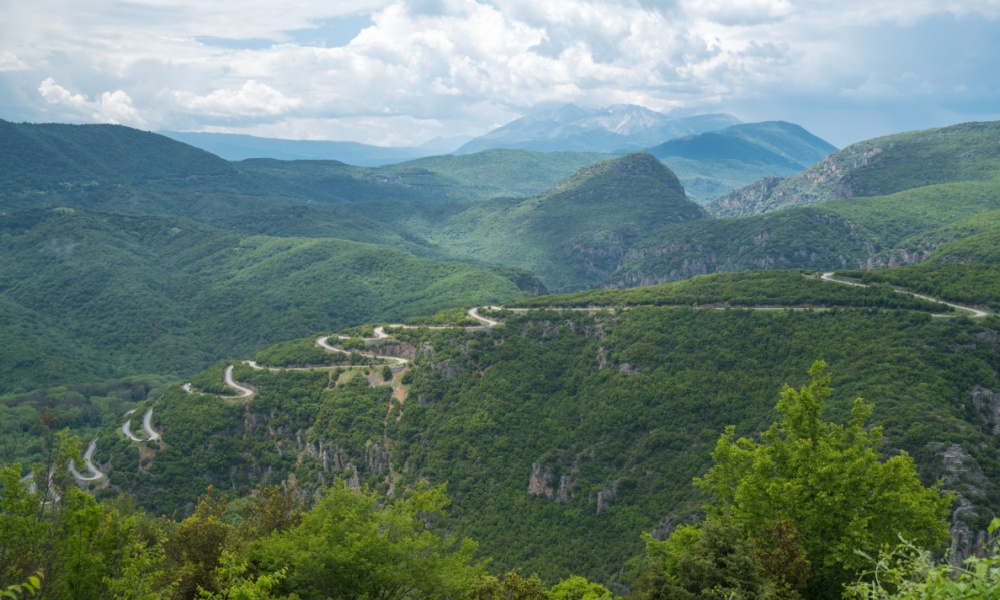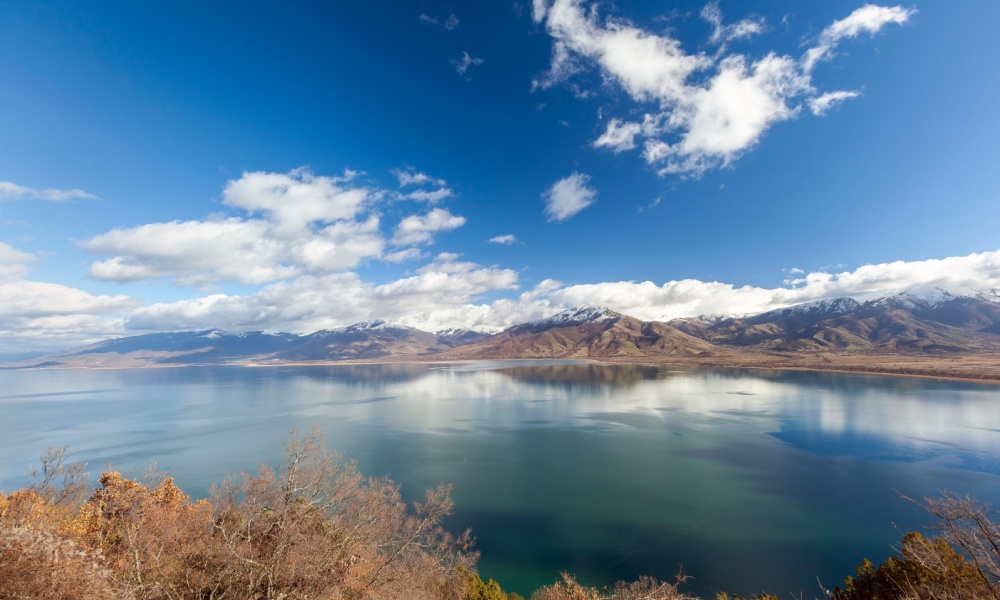Many travelers flock to Greece to explore the ancient wonders of Athens or soak in the beauty of its iconic islands like Santorini. And these are certainly worthy pursuits. But beyond these well-known spots, Greece has a wealth of hidden gems that are just as rich in history and breathtaking scenery. From secluded natural retreats to cultural landmarks that often fly under the radar, these destinations offer a deeper, more intimate look at the country’s diverse landscapes and heritage.
Let’s dive into some of these lesser-known treasures that might just change the way you experience Greece.
Zagori: The Mountainous Beauty

Vikos Gorge, Zagori
Tucked away in a secluded corner of Northern Greece is Zagori, a region of rolling mountains and quaint stone villages that welcome visitors with unparalleled charm and hospitality. The area has a long history dating back to Byzantine times, with many of its villages still featuring centuries-old stone bridges and monasteries. Zagori is also home to Vikos-Aoös National Park, a UNESCO Global Geopark renowned for its dramatic cliffs, dense forests, and beautiful mountain views. Nature lovers will find themselves in awe while exploring the park’s many trails, including a trek to Vikos Gorge—the deepest gorge in the world.
After traversing Zagori’s rugged mountain paths, head to one of the region’s 46 villages to admire the historic architecture and indulge in its distinct local cuisine. Zagori’s food reflects the region’s pastoral heritage, offering hearty dishes such as kleftiko (slow-cooked lamb), batzina (a savory zucchini pie), and paprikas (stews made with pork and vegetables), all perfect for refueling after a day of exploring.
The Mani Peninsula: A Journey Through History

Vatheia, Greece
Located near the southernmost tip of mainland Greece, the Mani Peninsula is rich in the history and culture of the Greek people. Throughout the centuries, empires ranging from the Spartans and Romans to the Byzantines and Ottomans all staked their claim on the peninsula in the hopes of controlling the wider Peloponnese. Ruins left by these conquerors dot the arid landscape of the Mani and provide exceptional tourism options for history-loving travelers.
Among the most fascinating destinations on the peninsula is the village of Vatheia, perched dramatically on a hilltop with sweeping views of the surrounding olive groves and the Aegean Sea. The village is a maze of narrow, winding streets lined with stone tower houses, a signature of Mani’s defensive architecture. These fortified structures, built between the 18th and 19th centuries, reflect the region’s turbulent past, when local clans constructed them to fend off invaders. Once abandoned, Vatheia has since been restored to its former splendor, with its towering homes standing proudly against the rugged cliffs.
Also of note is Mystras, a Byzantine castle and fortified town on Mount Taygetos. Home to several beautiful churches and a wonderful palace complex, Mystras is a UNESCO World Heritage Site that offers a fascinating look into Greek art and architecture during the Byzantine era.
Ikaria: The Island of Longevity

Village of Evdilos, Ikaria island
For decades, vacationers interested in wellness have flocked to the island of Ikaria to learn the secrets of the legendary longevity of its lucky residents. Due to a combination of good genes, healthy diet, and an easygoing lifestyle, inhabitants of the small, unassuming island just off Samos often live well into their 90s. Head to one of the island’s spa retreats to learn more about how to lead a healthier lifestyle and partake in the healing properties of Ikaria’s many geothermal hot springs. Renowned for centuries, Ikaria’s geothermal hot springs have purportedly helped to treat everything from anxiety to certain types of circulatory problems and kidney disease.
Wellness-minded visitors to Ikaria will also not want to miss their chance to dip their toes into the island’s azure waters. Beach resorts throughout Ikaria place a heavy focus on luxury and comfort, helping visitors relax and forget the humdrum of their daily life for a few moments.
Nymfaio: A Hidden Mountain Village

The town of Nymfaio on a snowy morning
Nestled in the passes of the snow-capped Verno mountains, the village of Nymfaio rests in a forest of beech trees, seemingly plucked from the pages of a book of fairy tales. Founded in the 14th century, Nymfaio is known throughout Greece for its historic atmosphere and natural beauty. Popular among holiday vacationers, Nymfaio embraces its whimsical charm with architectural tours of the village. Stately mansions and guesthouses on cobblestone streets await visitors on every corner, while the Museum of Gold and Silver-smithery, Folklore, and History takes guests on a journey through Nymfaio’s storied past.
Nature-loving visitors to Nymfaio will also want to check out hiking and mountain biking trails that wind through the forests outside the village. The Arcturos Environmental Centre, a sanctuary for former circus bears, is also an ideal spot for animal lovers to spend an exciting afternoon.
Prespa Lakes: A Natural Wonderland

Big Prespa Lake
The Prespa Lakes, the highest tectonic lakes in the Balkans, represent the pinnacle of Greece’s natural beauty. Located at the point where the borders of Greece, Albania, and North Macedonia all meet, the Prespa Lakes are a system of two lakes, Great Prespa and Little Prespa, that are divided by a narrow isthmus. Famous for their serene waters and verdant shoreline, the Prespa Lakes are best known as a top-tier bird watching destination. Herons and egrets are all regular visitors to the Prespa Lakes, and the region is also the nesting site for rare migratory birds like the Dalmatian pelican.
Like any aquatic paradise, the Prespa Lakes are also great for visitors hoping to engage in water activities, including kayaking and paddleboarding. Meanwhile, hiking trails adjacent to the lakes allow visitors to get up close and personal with the area’s incredible natural vistas. Some trails even take visitors to the ruins of Byzantine hermitages that have stood since the 13th century.
You Might Also Enjoy: From Mykonos to Santorini, Summer is the Best Time to Visit Greece!
Tinos: Beyond the Pilgrimage

Church of Panagia Evangelistria, Tinos
For centuries, the island of Tinos has been synonymous with devotion to the Virgin Mary, with thousands of pilgrims visiting the Church of Panagia Evangelistria each year to pay their respects. But there are many more remarkable things to see and do on this small island in the middle of the Cyclades.
Tinos is home to over 60 villages, each with its own distinct charm and personality. Among the most visited villages on the island is Pyrgos, a community celebrated throughout Greece for its masterful marble craftsmanship. Nearly everything in Pyrgos is adorned with meticulously sculpted and constructed marble, from fountains and churches to the village’s very streets. Visitors here can watch artisans skillfully shape new creations in the village’s open marble workshops or take a tour of the Museum of Marble Crafts to learn about the history and tradition of marble working in the region.
Of course, no visit to Tinos can be complete without a trip to one of the island’s incredible beaches. The beaches on Tinos’ southern coast are particularly well regarded for their many amenities and calm waters. The beach at Agios Ioannis Porto is among the most popular tourist destinations on the island for its beautiful white sand beaches and resort facilities.
FAQs:
Q: What’s the best time of the year to visit these lesser-known Greek destinations?
A: The ideal time to visit is during the shoulder seasons of spring (April to June) and fall (September to October). The weather is pleasant, and these areas are less crowded, allowing for a more authentic experience.
Q: Are there any special considerations for transportation in these areas?
A: Renting a car is highly recommended as many of these destinations, like Zagori and the Mani Peninsula, are remote and public transportation options are limited.
Q: What should I pack for a trip to these regions?
A: Pack comfortable walking shoes for exploring, layers for varying temperatures, and sun protection. In mountainous areas like Zagori, include warm clothing even in summer.
Q: Are these destinations family-friendly?
A: Yes, many of these areas offer activities for all ages, such as hiking in Vikos-Aoös or exploring the beaches of Tinos. However, some locations like Vatheia may have rugged terrain that requires caution with younger children.
Q: Is English widely spoken in these regions?
A: English is commonly spoken in tourist areas, However, in more remote villages, knowing basic Greek phrases can be helpful. Locals are generally friendly and willing to assist visitors.
Q: Are there vegetarian or vegan food options available?
A: Greek cuisine offers a variety of vegetarian dishes, such as vegetable pies and salads. Vegan options may be more limited, but many tavernas are accommodating if you explain your dietary needs.
Q: Do I need to book accommodations in advance?
A: It’s advisable to book accommodations in advance, especially during peak travel times like summer. Many of these areas have limited lodging options, and popular spots can fill up quickly.
Have any other secret havens for a big, fat Greek getaway? Let us know in our comments section below!




Leave a Reply